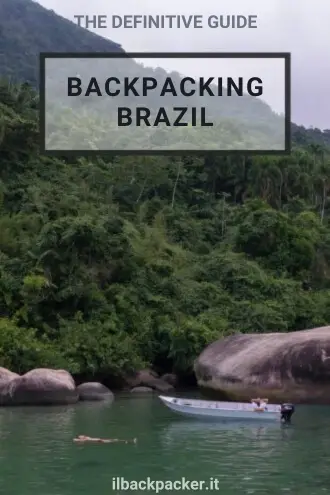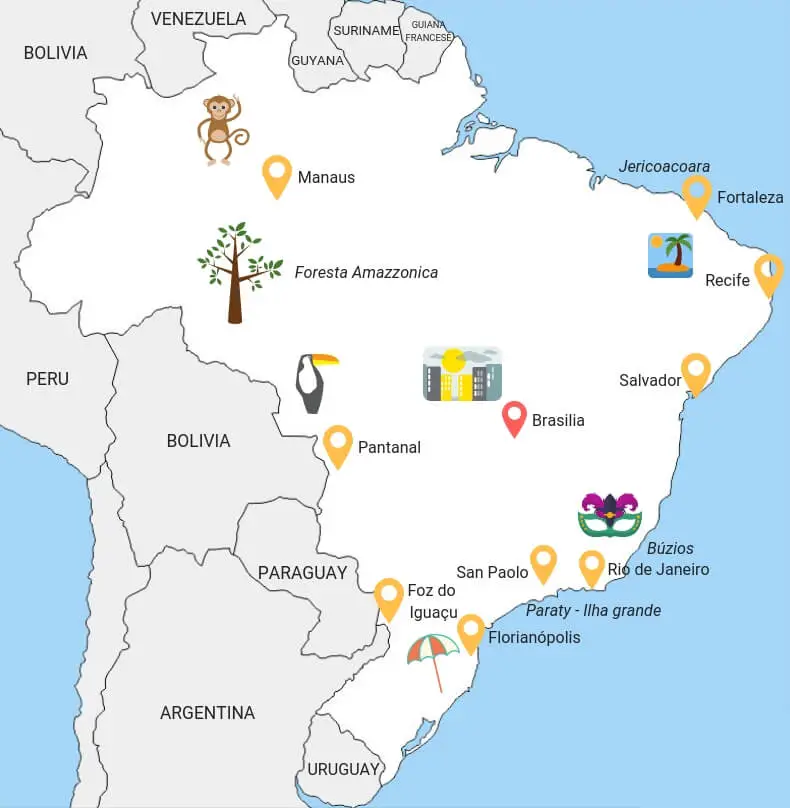Brazil Travel Guide
Brazil is the largest country in South America and the fifth largest globally. It is a place where diversity reigns supreme: from metropolises such as São Paulo and Rio de Janeiro, which, as everyone knows, is home to the world’s most famous carnival, to the unspoiled nature of the Amazon rainforest, throwing in dreamy beaches, colonial cities, an unbridled passion for soccer, and incredible people—in short, there is something for everyone!
In this guide, you’ll find plenty of valuable tips to help you make the most of your trip to Brazil, as always, with an eye on budget.
Quick menu
- When to visit Brazil
- Documents and vaccinations to enter Brazil
- What to do and see in Brazil
- Suggested itineraries in Brazil
- How to get around Brazil
- Backpacking Brazil: costs
- Backpacking Brazil: Safety
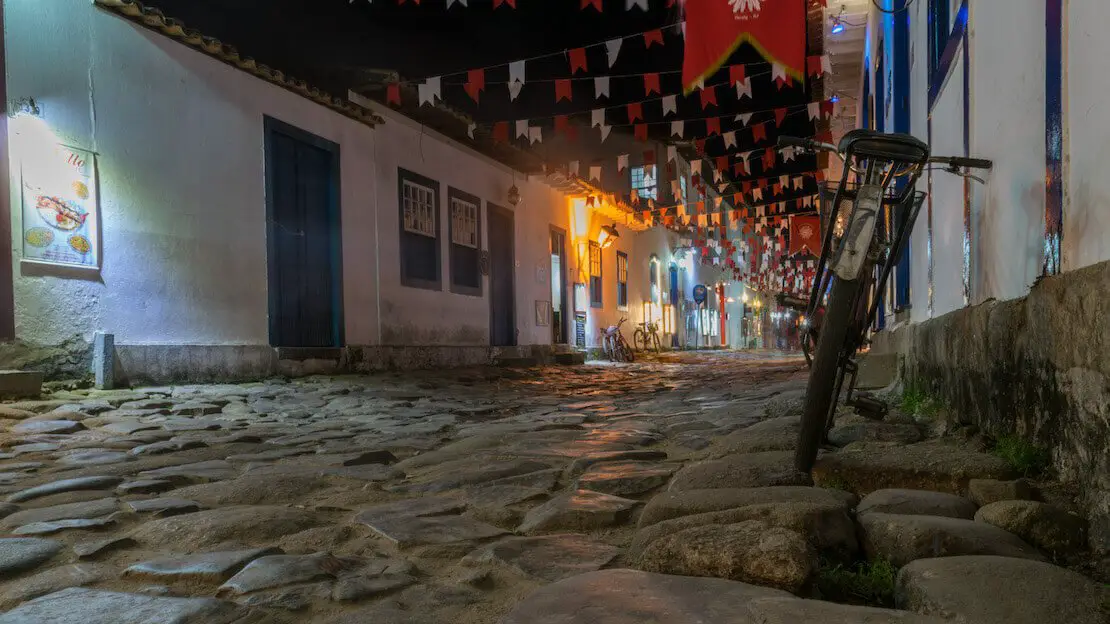
Paraty.
When to visit Brazil
When discussing climate, it is good to consider that the country can be divided into at least three distinct climatic regions.
South and southeast: Broadly speaking, Belo Horizonte, Rio de Janeiro, São Paulo, and Porto Alegre. Here, it can be “cold” from June to September, with temperatures that, in any case, rarely drop below 15-20 degrees during the day. Along the coast, the climate is more temperate than inland; obviously, the further south you go, the colder it gets. Rainfall is most frequent during December-February but can occur throughout the year.
North and Northeast: It is never cold, with average temperatures hovering between 25 and 30 degrees throughout the year. The months from August to February are generally the driest, and those between March and July are the rainiest.
Amazon Rainforest and Pantanal
It is hot and humid throughout the year, but rainfall is concentrated between December and March; temperatures hardly drop below 20 degrees, even in winter. The best time to visit these regions is from May to October, during the dry season when animals are attracted to a few bodies of water; July and August are by far the best as temperatures are the lowest of the year.
Defining the best time to visit Brazil is challenging and depends significantly on the region you want to see. In any case, the period from the end of August to the end of October is a good compromise in most parts of the country.
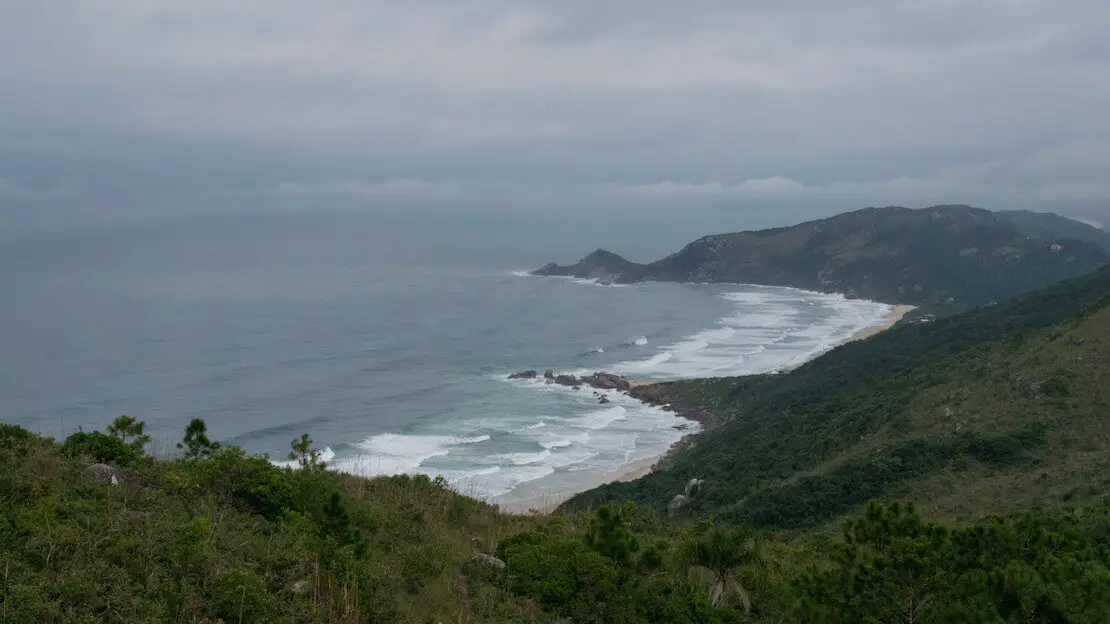
Florianópolis.
Documents and vaccinations to enter Brazil
Most passport holders receive a 90-day free tourist visa when they enter the country.
The visa can be renewed for 90 days by applying to the federal police. You cannot stay in the country for more than 180 days during 12 months. If you want to renew your visa, I refer you to this step-by-step guide.
Brazil requires no mandatory vaccinations, but Hepatitis A and B are recommended. As for Yellow Fever, although it is not needed, it is highly recommended, especially if you decide to visit high-risk areas.
What to do and see in Brazil
When it comes to such a large country, there are many possible tourist destinations, and someone could easily spend years travelling around Brazil. In this section, you will find the main destinations I recommend you visit due to my personal experience, hearsay from other travellers, and research I have done.
This guide expresses prices in the local currency called “Brazilian Real,” often abbreviated as “BRL.” The exchange rate at the time of publication of this article is 1€ = 5.58 BRL. I recommend you look at this page for the current exchange rate.
In Brazil there are plenty of airports to fly to, and those in the south, especially near Porto Alegre, São Paulo, and Rio de Janeiro, are often the cheapest. That’s why I will start right from the south of the country.
N.b. Several times throughout the guide, you will find links to https://www.tails.com/. Upgrade to the pro version if you want offline navigation directly from the Alltrails app. However, you can get around this by downloading the coordinates from the site’s desktop version in “Google Earth KML” format and then uploading them to organic maps, which is by far one of my favourite travel apps.
Foz do Iguaçu
Foz do Iguaçu is the sister city of Puerto Iguazu but much larger and more developed. The city was founded and grew as an access point to the nearby Iguazu Falls that Brazil shares with Argentina, but it also offers other exciting activities.
In case it was unclear, there are two sides to Iguazu Falls: the Argentine and Brazilian sides, which are distinct and should be visited separately. Composed of some 275 individual waterfalls, they all form one of nature’s seven wonders.
What is the difference between the Brazilian and Argentine sides of Iguazu Falls?
The Argentine side, with its system of footbridges, takes you “inside” the falls and allows you to experience their power up close, while the Brazilian side offers a panoramic view of the falls. Both sides have their charm, and if you can, I recommend visiting both. However, if you have to choose due to time or budget constraints, I recommend prioritising the Argentine side.
It is possible to visit both sides on two separate days using Foz do Iguaçu as a base and crossing the border by taking a bus from the Foz do Iguaçu terminal to the Puerto Iguazú terminal, from here, buses to the falls depart about every 20 minutes starting at 7 a.m.
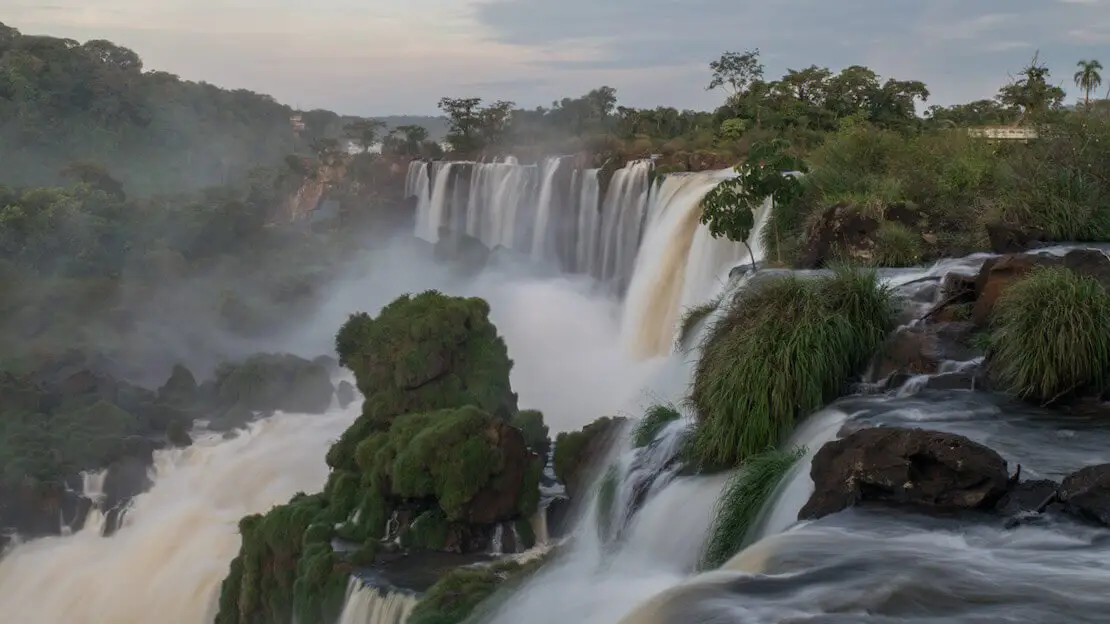
Iguazu Falls (Argentine side).
What to do and see in Foz do Iguaçu.
The waterfalls are the main attraction, but below, I have also listed other activities that can be done in and around Foz do Iguaçu.
How to visit Iguazu Falls (Brazilian side)
The cheapest way to reach the falls is via one of the many public buses that depart every 10 minutes from the bus terminal and make numerous stops (ask your hostel/hotel which one is closest), costing 3.45 BRL one way. The bus is the same one that goes through the airport and Das Aves Park. The entrance to the falls is the last stop, approximately half an hour away.
The ticket costs BRL 80 and can also be paid by card at the entrance or online (official website). Once you pay the entrance fee, you board a bus and get off at the “Trilha Das Cataratas” stop, where virtually everyone gets off anyway. There is a walking trail that takes you all the way to the main falls with various viewpoints on the Argentine side of the falls along the way. The trail ends at a picnic area with restaurants and stores; here you can board the bus again to return to the entrance. Even going very slowly, 2 hours is more than enough; the trail is really short. The park is open from 8 a.m. to 5 p.m. during winter and from 8 a.m. to 6 p.m. in summer.
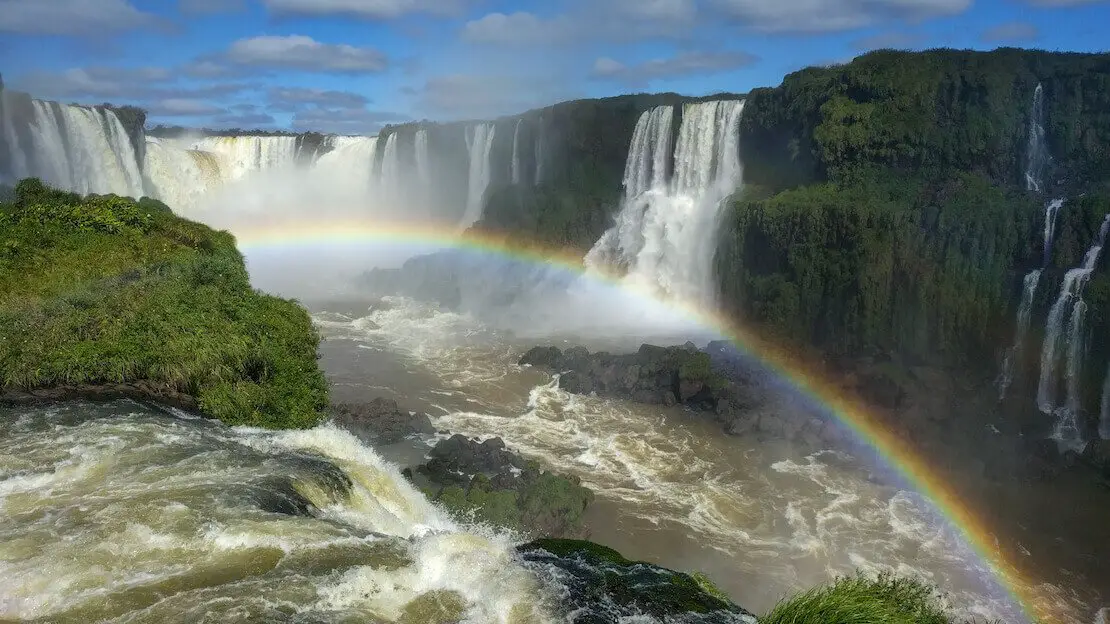
Iguazu Falls (Brazilian side).
Parque das Aves
The park (Google Maps) is located just outside the entrance to the falls (returning to the main road exactly on the other side) and can easily be visited on the same day.
It is a walking tour through giant cages nestled in the jungle that is home to about 900 birds of 180 different species, some reptiles and butterflies. All the animals can be seen from a few metres away, and I recommend it. Again, 2 hours is more than enough time. The cost of admission is 80 BRL. The park is open from 8:30 am to 5:30 pm during winter and from 8:30 am to 6 pm in summer.
Itaipu Dam
This is the second largest dam in the world in terms of hydroelectric production, halfway between Paraguay and Brazil. It can be visited from both sides, but I recommend the Paraguayan one as the tour is free (the government offers it to boost tourism) and can be incorporated into a short trip to Paraguay as described in my travel guide, perhaps along with the beautiful Jesuit ruins in Trinidad.
If you don’t feel like crossing the border or have the time for it, you can join the tour from the Brazilian side. The cost is BRL 58, and it is a scenic tour of the dam. There are direct buses that leave from the bus terminal.
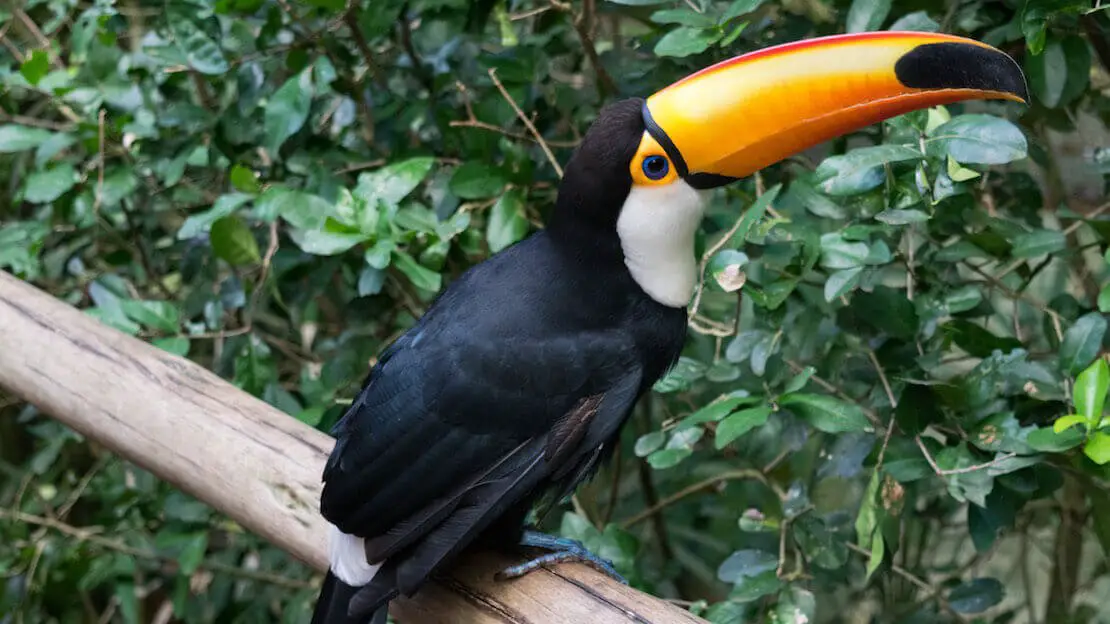
Parque das Aves.
Marco das Três Fronteiras and Buddhist temple
These are two sites that are not particularly exciting, in my opinion, but if you have time on your hands, they are worth a tour.
The Marco das Três Fronteiras (Google Maps) is where the borders of Brazil, Argentina, and Paraguay meet in the middle of the river. Each country has its little monument, and Brazil has just renovated it; there is a nice view of the river, but it ends there.
While at the Buddhist temple (Google Maps), the main attraction is a large golden statue of a seated Buddha. Both sites are accessible by public transportation and are really close to the city center.
Where to sleep in Foz do Iguaçu?
Tetris Container Hostel is very special because, as the name suggests, it is built from recycled containers. The hostel is clean and well-maintained, with excellent common areas, including a swimming pool. Breakfast is included.
How to reach Foz do Iguaçu?
There are frequent buses to and from Ciudad del Este and Puerto Iguazu, where you can continue your journey to Paraguay or Argentina. Foz do Iguaçu is also connected to all the major cities in southern Brazil, Florianópolis, São Paulo, and Rio de Janeiro, just to name a few. If booked in advance, domestic flights in Brazil are cheap.
Pantanal
Pantanal is the largest wetland in the world, a vast floodplain subject to periodic flooding. It is one of the largest freshwater ecosystems globally, and the chance of observing wildlife is higher than in the Amazon rainforest, especially during the dry season when jaguar sightings are relatively frequent, making it the best place in the world for that purpose.
Given its size, there are several access points. The two most popular are Cuiabá for the north and Campo Grande for the south. Once you arrive in either of these towns, relying on a local agency is advisable. The most popular format is the all-inclusive packages, including a transfer to a lodge (fazendas) where you spend a few nights participating in guided activities to explore the Pantanal. Unfortunately, I haven’t personally visited the area. I recommend checking out this guide.

How to reach the Pantanal?
From the south, there are numerous direct buses to Campo Grande, 22 hours from Rio, 16 hours from São Paulo, and about 10 from Foz do Iguacu.
From Paraguay, you can cross the border at Pedro Juan Caballero; from Bolivia, you can take a train from Santa Cruz to Puerto Suarez, cross the border, arrive at Corumbá, and take a bus to Campo Grande.
As for Cuiabá, the most likely connections are from Campo Grande, which is 12 hours, and Brasilia, which is about 20 hours. Both Campo Grande and Cuiabá are well served by daily local flights, which can be convenient.
Florianópolis
Florianópolis is a very special city that is split into two parts. Half is on the mainland, and the other half are on the giant Catarina Island, which is not far from the coast and connected by three bridges.
The city has grown in popularity as a tourist destination in recent years, thanks mainly to the fantastic beaches, the good surfing conditions, and the fact that the city is nowhere near as chaotic as other Brazilian metropolises.
Catarina Island can be divided into three areas: north, which is heavily developed, and where the main resorts and luxury hotels are located. The center of the island, which is to the west of downtown Florianópolis and finally the east, where we find Lagoa da Conceição and Barra Da Lagoa; here, the atmosphere is much more relaxed, most hostels are located here. The very south of the island is sparsely developed and almost uninhabited; many beaches can only be reached by jungle trails.
What to do and see in Florianópolis
There are 42 beaches, some great for surfing, others for swimming, some isolated, some practically deserted; in short, options for all tastes. Plenty of trails across the island are suitable for longer or shorter treks, including one of about two hours at the “Lagoa do Leste” beach, considered one of the most beautiful in the country (All Trails).
For windsurfers, Lagoa da Conceição offers excellent conditions and is a world-renowned destination. There is also a lively nightlife.
The only note I would make is that being so far south, from June to September, it is not really hot, and since it is a beach destination, it may be better to go somewhere else. I was there in May and got lucky with nice warm days, but it is already considered low season, and the hostels were semi-deserted. January and February are the hottest and most expensive and crowded months.
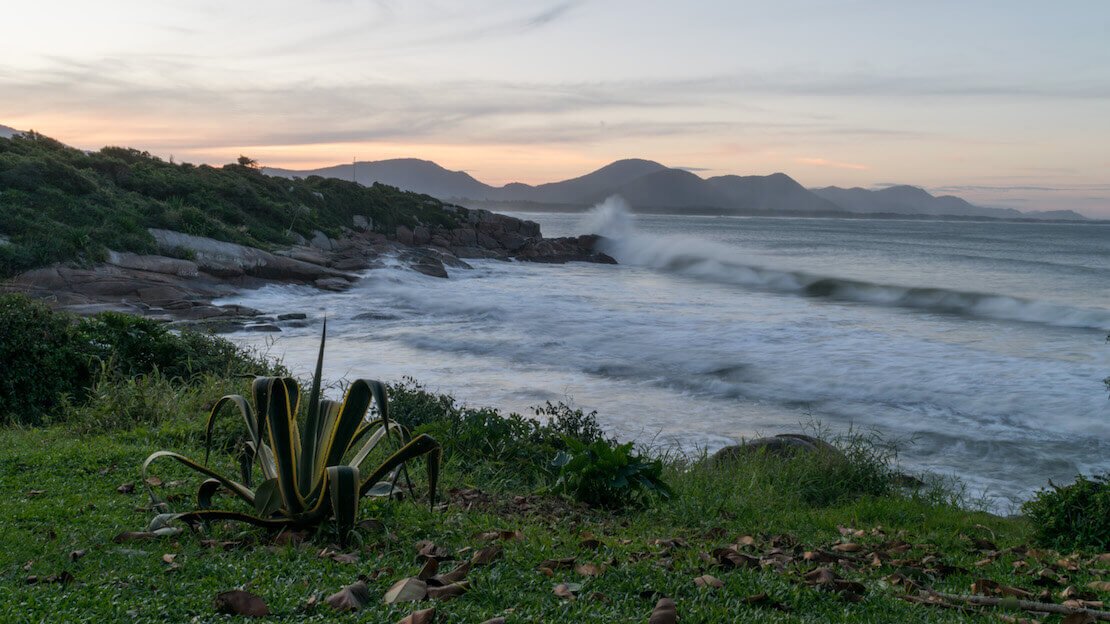
Florianópolis.
Where to sleep in Florianópolis?
I slept in a hostel in Barra da Lagoa by the sea. The village is small, but there are a couple of supermarkets and beaches within walking distance without necessarily having to take the bus. The island has many options, from party hostels, mainly in Lagoa da Conceição, to eco hostels. Take a look here.
How to reach Florianópolis?
Foz do Iguaçu is about 16 hours by bus, from Porto Alegre is about 6 hours, and São Paulo is 12 hours away. Of course, there are also buses to other major Brazilian cities. As always, it is also worth looking at domestic flights for long distances.
N.b. Urban transport in the city and on the island operates similarly to the subway; once inside the system, you can travel anywhere by changing lines at various stations, and the ticket costs 3.10 BRL. The city bus station is just outside the bus terminal on the right. Each hostel can provide precise instructions on which line to take to reach a particular part of the island.
São Paulo
One word to describe São Paulo is “giant.” We are talking about a city with 11 million inhabitants and more than 20 in its metropolitan area. The city is not particularly touristy and is often overshadowed by other cities such as Rio de Janeiro and Salvador. Still, São Paulo is undoubtedly one of the most energetic cities in the world and it’s worth a couple of days.
What to do and see in São Paulo
As always, in big cities, many free walking tours are offered that cover the main tourist areas. There are many museums and parks, but for many travelers, the main attraction remains the Vila Olímpia (Google Maps) and Vila Madalena (Google Maps) neighborhoods. Here we find the center of São Paulo’s nightlife and most hostels.
The city is not just about the nightlife, however: the historic center (Google Maps), which went through a period of decay in the past, is recovering thanks to projects and investments, and although it is not particularly impressive, it is worth a walk. Here, you will find many of the baroque and neoclassical buildings in the city.
Avenida Paulista (Google Maps) is probably the symbol of São Paulo, a bit like Fifth Avenue in New York City. Walking along Avenida Paulista and its surroundings, filled with restaurants, hotels, bars, and stores, is a good way to spend half a day.
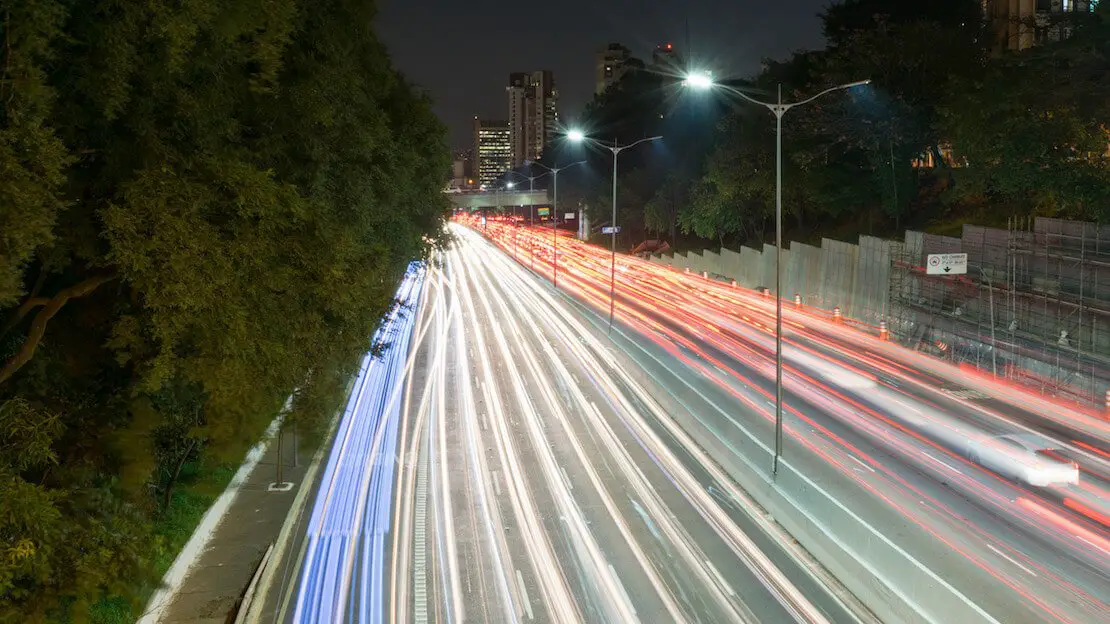
São Paulo.
Where to sleep in São Paulo?
I preferred the Vila Mariana neighbourhood as it was cheaper and close to a local friend. The hostel I stayed in is Tapera Hostel. It is nice and clean. The neighbourhood is safe, and the hostel is a short walk from the metro. If you are looking for hostels that are more “social” and frequented by travelers, I recommend the area around Vila Madalena.
How to reach São Paulo?
From São Paulo’s three bus terminals, it is possible to reach virtually all major cities in Brazil and even some international destinations. All terminals are directly connected to the metro. It is also worth looking at possible domestic flights as they are often cheaper than buses.
Paraty
It is a pretty little colonial coastal town about halfway between São Paulo and Rio de Janeiro. Founded by the Portuguese in 1667, it still preserves its cobblestone streets and numerous colonial buildings. Beautiful beaches and paradise islands also surround the town; in short, a great compromise between nature and culture!
What to do and see in Paraty
The historic center of the city is easily explored on foot, in any case, vehicles are not allowed. It is especially pretty in the evening when people and stalls line the streets.
Waterfalls
There are numerous waterfalls in the forest surrounding Paraty. Many local facilities and agencies offer a jeep tour. As always, I preferred the do-it-yourself option. It is possible to reach Cachoeira do Tobogã and Poço do Tarzan by bus and then take a short walk through the forest.
Tobogã (Google Maps) is probably the most famous waterfall in Paraty and, therefore, very crowded on weekends. Watch the video to see what you can do at this waterfall!
The bus to take is the one to Penha. It leaves from the bus station (Google Maps) and drops you off exactly at the beginning of the short path. On the other side of the road is a Cachaça (a sugarcane-based liquor) distillery where a tour with a final tasting is offered (Google Maps).
Trindade
It is a town near Paraty with some really nice beaches. Praia do Rancho (Google Maps) is the main beach with bars and restaurants; I advise continuing to Praia do Meio (Google Maps) or Praia do Cachadaço (Google Maps) along the path that goes through the jungle for some stretches. At the end of the trail, after crossing all the beaches just mentioned (about 45 minutes), there is a natural pool formed by giant rocks on one side and a forest overlooking the sea on the other. It’s a really nice place to relax and swim without the strong ocean currents (Google Maps).
Buses to Trindade leave about every hour from the Paraty bus station.
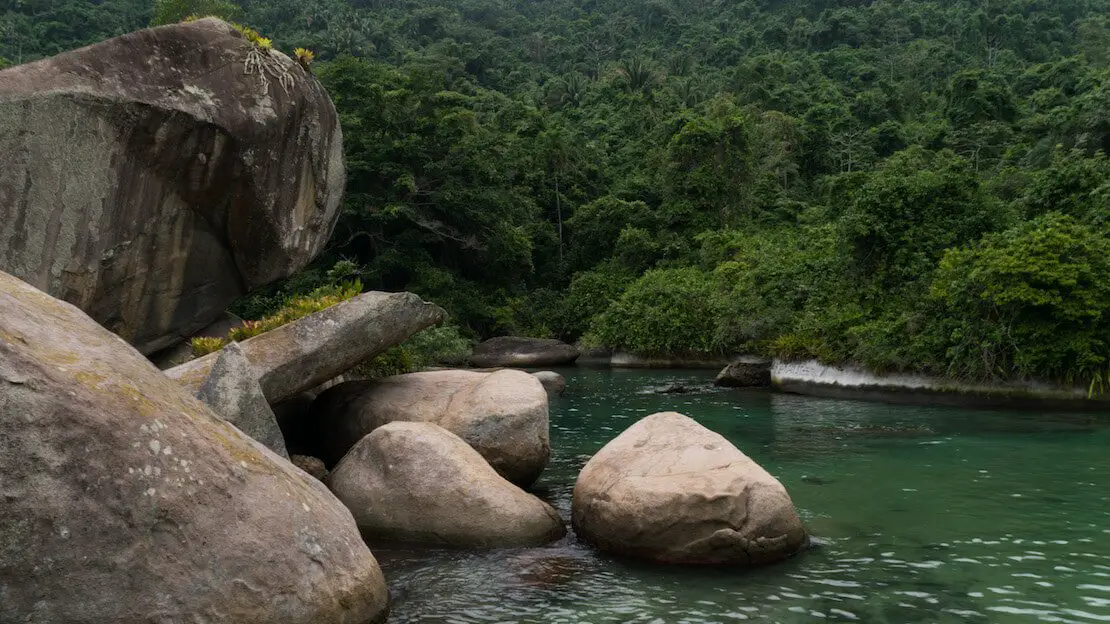
Trindade natural pool.
Boat Tours
There are plenty of options here. You can rent smaller or larger boats privately or by tour. You visit islands (more than 300 in the surrounding area) and isolated beaches that can only be reached by boat. Tours offer different itineraries and activities, including diving.
I joined a couple of guys I had met a few days earlier who, through the hostel, had booked a tour with a “party boat” of sorts. I simply followed them in the morning, and after talking to the captain, I closed the deal for 100 BRL…with unlimited caipirinha!
If you feel like bargaining, my advice is to go directly to the harbor and negotiate with the captains of the many boats that leave each morning and choose what you are most comfortable with.
Where to sleep in Paraty?
Girassol Hostel by Katita is recommended. Clean and cheap hostel, excellent location.
How to reach Paraty?
From Rio de Janeiro, it is about 4½ hours with several daily departures, with Costa Verde. From São Paulo it is 6-7 hours with reunidas Paulista.
From Ilha Grande, the cheapest way is via the ferry that leaves daily at 10:00 a.m. from Vila do Abraão to Angra dos Reis (about an hour and a half, BRL 15). The suburban bus stop connecting Paraty from the pier is not far away (about an hour and a half, BRL 15). However, if you miss the ferry, numerous speed boats shuttle very frequently but are more expensive, about BRL 40. In any case, I recommend that you ask your hostel about schedules because they change frequently.
The more expensive but more practical and faster alternative is to use easytransfer; The route Paraty – Ilha Grande includes minivan transfer with pick up directly at the accommodation plus speed boat to Ilha Grande or vice versa.
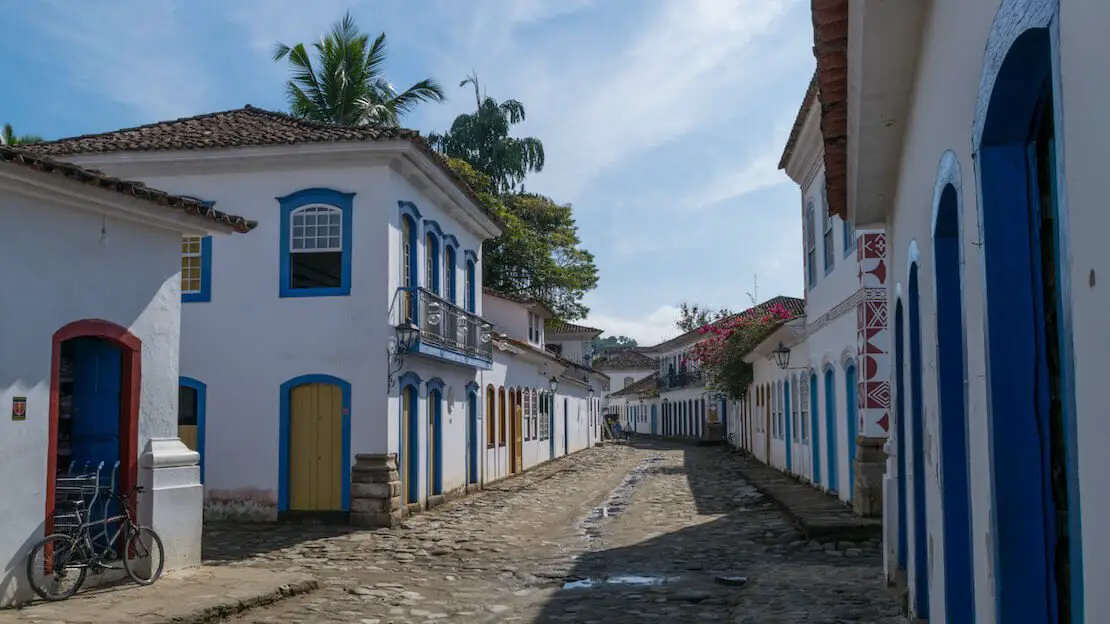
Paraty.
Ilha grande
As the name implies, it is a large island (almost 200 km²) located about 150 km south of Rio de Janeiro. The island was used as a lazaret for years and housed a maximum security prison, only closed in 1994. Thanks largely to this, the island has not seen any kind of urban development and still retains one of the most pristine Atlantic forests in the country.
There are no roads or private vehicles on the island, and almost 90 percent of its land is within a protected area; the largest settlement with a population of not even 2,000 people is Vila do Abraão, where the port is located. In short, it is an almost untouched island paradise just a stone’s throw from civilization.
What to do and see in Ilha Grande
On the island, we find some of the most beautiful beaches in Brazil. Lopes Mendes was literally voted by Vogue as one of the ten most beautiful beaches in the world. But many others are just as spectacular and can be reached by the many well-mapped paths (found on organic maps) that crisscross the island or by boats that serve as taxis.
Lopes Mendes Beach
It cannot be reached directly by boat, but one can get to nearby Pouso (BRL 15-25) and walk through the forest in about 20 minutes. For those who want to save money at all costs (like me), you can easily walk along the well-marked path from Vila do Abraão shortly after the Che Lagarto hostel (Google Maps), it’s about 7 km.
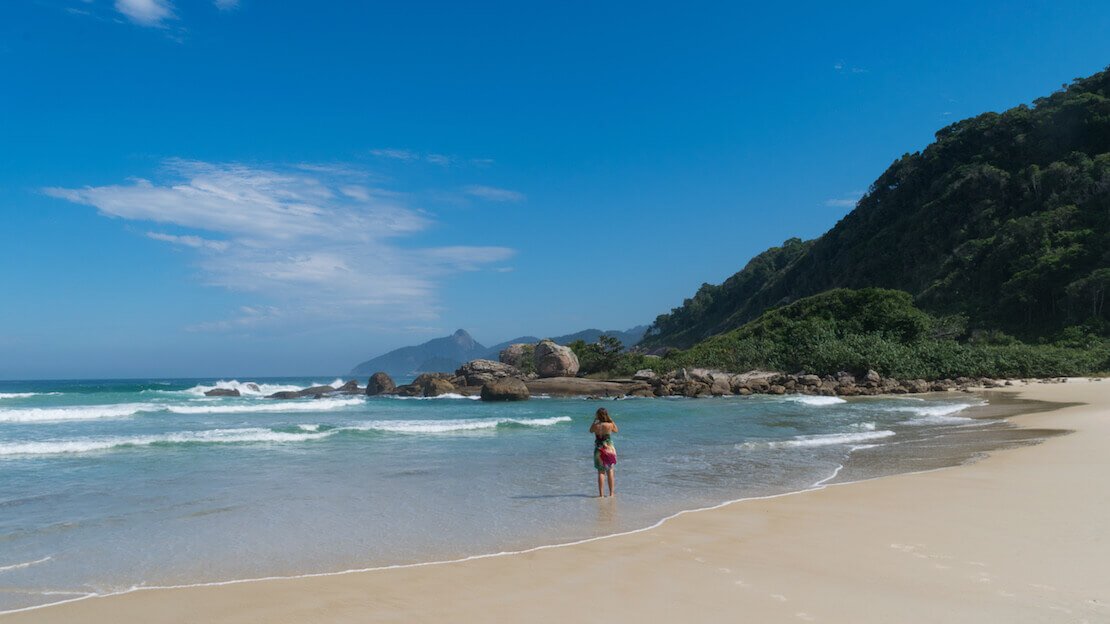
Lopes Mendes beach.
Cachoeira Da Feiticeira Waterfall
It is a nice waterfall located about 4km from Vila do Abraão (Google Maps); the well-marked path starts at the end of the beach in the opposite direction to the one leading to Lopes Mendes. From here, it is possible to reach several beaches not far away; I have been to Praia Da Feiticeira (Google Maps) and it is beautiful. To return, you can either follow the path backward or rely on the boats that go back to Vila do Abraão.
Pico do Papagaio
Visible from Abraão, it has this name because, when observed from certain angles, it resembles the head of a parrot with a beak. At 980 meters high, it is the second highest point on the island. Some companies offer a tour to see the sunrise from the top, but the path is easy enough to follow and is marked on organic maps (All Trails). However, I recommend not doing it alone and ensuring you have a decent, charged flashlight, as it is completely dark in the forest.
Starting from Vila do Abraão is about 2-3 hours, depending on the pace; the views are spectacular. Bring a sweatshirt because once you get to the top it is often windy and before the sun rises it can get cold, don’t forget water.
These listed so far are, of course, just some of the activities and beaches on the island; there are numerous boat tours, including the one to Lagoa Azul (Google Maps) that seems popular, but also numerous other beaches that are not within walking distance. In conclusion, if you are looking for a beach near Vila do Abraão, I recommend Praia do Morcego (Google Maps).
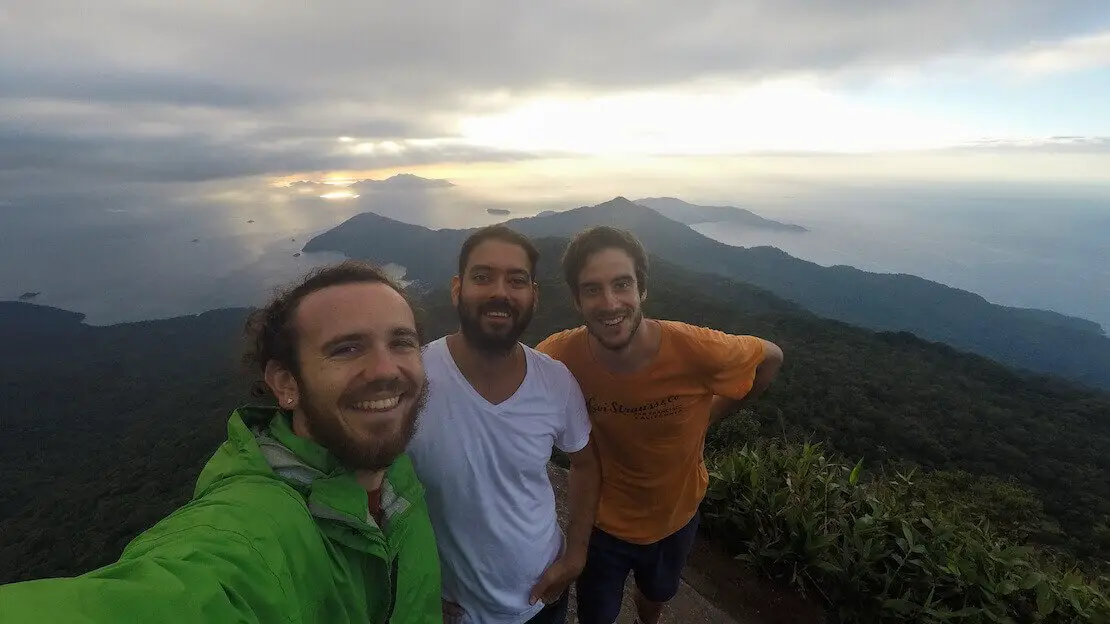
Pico do Papagaio at sunrise.
Since I no longer run ads, if you found this article helpful, please consider purchasing your travel insurance through one of the links on this site. Doing so supports my work at no additional cost to you. For EU and UK residents, I recommend True Traveller. For everyone else, I recommend HeyMondo, which offers a 5% discount. Thank you for your support!
Where to sleep in Ilha Grande?
Hostel Refúgio offers excellent value for money. The hostel is clean, breakfast is included, and the rooms have air conditioning. Recommended.
How to reach Ilha Grande?
The cheapest way to get to Paraty is via the suburban bus from Paraty to Angra dos Reis (about an hour and a half, BRL 15). Not far away, the ferry (BRL 15) leaves at 3:30 pm. In any case, I recommend asking your hostel for the schedule because it changes frequently. This is the only ferry of the day; if you miss it, numerous speed boats shuttle very frequently but are more expensive, about 40 BRL.
From Rio de Janeiro, the cheapest way is to take the Costa Verde bus to Mangaratiba (37.50 BRL) at 5:00 and then take the 8:00 ferry to Vila do Abraão, 15 BRL. This is the only ferry of the day; if you miss it, you can take one of the many speed boats that shuttle for BRL 30.
The more expensive but also more practical and faster alternative is to use easy transfer; the cost is BRL 85 for the Paraty – Ilha Grande route and includes minivan transfer with “pick up” directly to the accommodation from Paraty plus speed boat to Ilha Grande or vice versa. Meanwhile, the Rio – Ilha Grande route costs BRL 95.
Rio de Janeiro
Rio is the second-largest city in Brazil and probably the best-known in the world, mainly for its carnival but also for its breathtaking scenery and some attractions such as the Cristo Redentor statue.
Called “Cidade maravilhosa” – literally “marvelous city” – by locals, it is truly unique, a city at times rich and modern, capable of hosting the Olympics, but at the same time surrounded by favelas, all set in a rather interesting geography, with rocky hills, lush forest, and beaches such as Copacabana and Ipanema.
What to do and see in Rio de Janeiro
Some people could easily spend weeks exploring Rio; I was there for a week and left feeling that I had not seen enough. Below, I list some of the activities I consider “must-do”, always with an eye on the budget.
Cristo Redentor
It is undoubtedly one of the city’s symbols and one of the most visited sites. The statue itself is not that impressive (I imagined it to be bigger), but the view of the city is, and despite the place being extremely touristy, I think a visit is worth it.
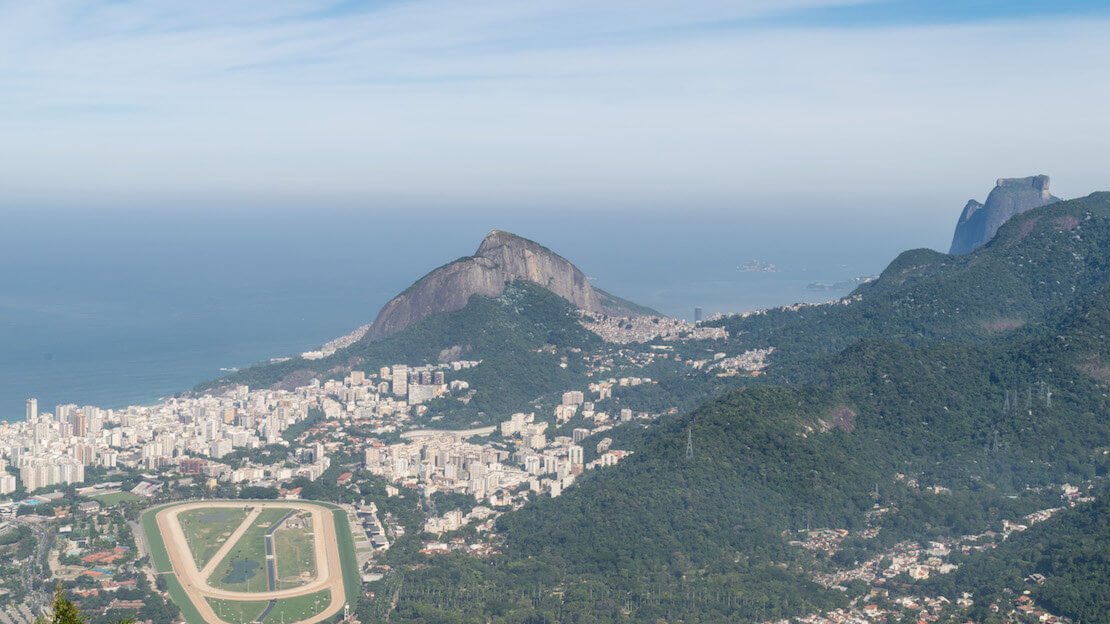
View from Cristo Redentor.
How to get to Cristo Redentor?
There are three ways to reach Cristo Redentor: on foot, by minivan, or by train.
On foot – A popular trail, especially among locals, starts from Parque Lage (Google Maps), about a two-hour walk uphill. The trail is marked and easy to follow, but unfortunately, robberies against tourists are all too frequent, so it is not recommended. The trail was officially closed to the public in the summer of 2017 and may still be closed.
The minivan (official website) – There are three pick-up points with departures every 15 minutes from 8:00 am to 5:00 pm. The three points are: Praça do Lido in Copacabana, next to the Lago do Machado metro stop and Città America in Barra da Tijuca. The price varies depending on the season, entrance to the Christ is included.
By train – The “Trem do Corcovado” station (Google Maps) is easily accessible by cab or metro. The train leaves every 20-30 minutes and takes about 20 minutes, running daily from 8:20 am to 5:00 pm. Buy your ticket online at this site. The cost, including entrance to Christ, depends on the season.
The train is probably the nicest way to go up, but I would take the van if I was staying near the van pick-up points. Due to frequent robberies, I would avoid the trail or walking up following the same road as the minivans. Whatever your choice, try to arrive early in the morning and avoid weekends to avoid the crowds.
Pan de Azucar
The Pão de Açúcar is another of Rio de Janeiro’s iconic sights; here you can have the best views of Rio de Janeiro at sunset. Going up is quite expensive as you have to take two cable cars. The first takes you up to Morro da Urca and the second to Pão de Açúcar proper for a total cost of about BRL 150.
To save money, I only took the second cable car and walked up Morro da Urca. The well-marked and maintained trail starts along the Cláudio Coutinho track (on the right along the beach looking at the Morro da Urca), and it takes about half an hour to go up. If you want to save money at all costs, you can go up to Morro da Urca, from where you still have a nice view of the city, but having arrived at this point, I recommend taking the cable car and going all the way up to Pão de Açúcar.
N.b. After watching the sunset (which I strongly recommend!) from Pão de Açúcar and returning to Morro da Urca, it was completely dark, and the access gate to the trail was closed. A guard opened it for me without any problem; just remember to bring a flashlight/cell phone, though! Otherwise, go down by cable car.
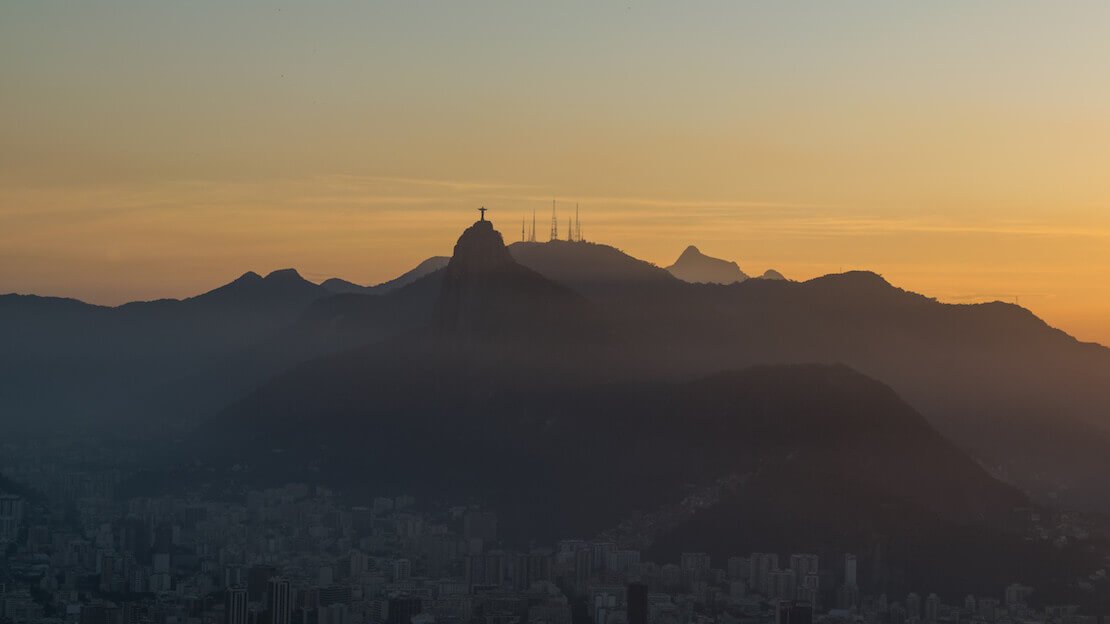
Sunset at Pan de Azucar.
Piedra de Gavea
Nice and fun hike to one of the best vantage points over the city (All Trails). The ascent is not particularly challenging, even though it is completely uphill. Still, there is a short section where you have to climb up the almost vertical rock face for about ten meters. When I went, there was a man who had set up a fixed rope to help climb it safely. He was charging around 20 BRL. However, I also saw people attempting it in flip-flops (which I don’t recommend).
How to get to the Pedra da Gávea?
From Copacabana/Ipanema, you can take a direct bus to Praça Euvaldo and get off close to the trailhead. I took an Uber with some other guys on the way up and then returned by bus. The trail is safe as the beginning is within a fenced residential area with a control station at the entrance.
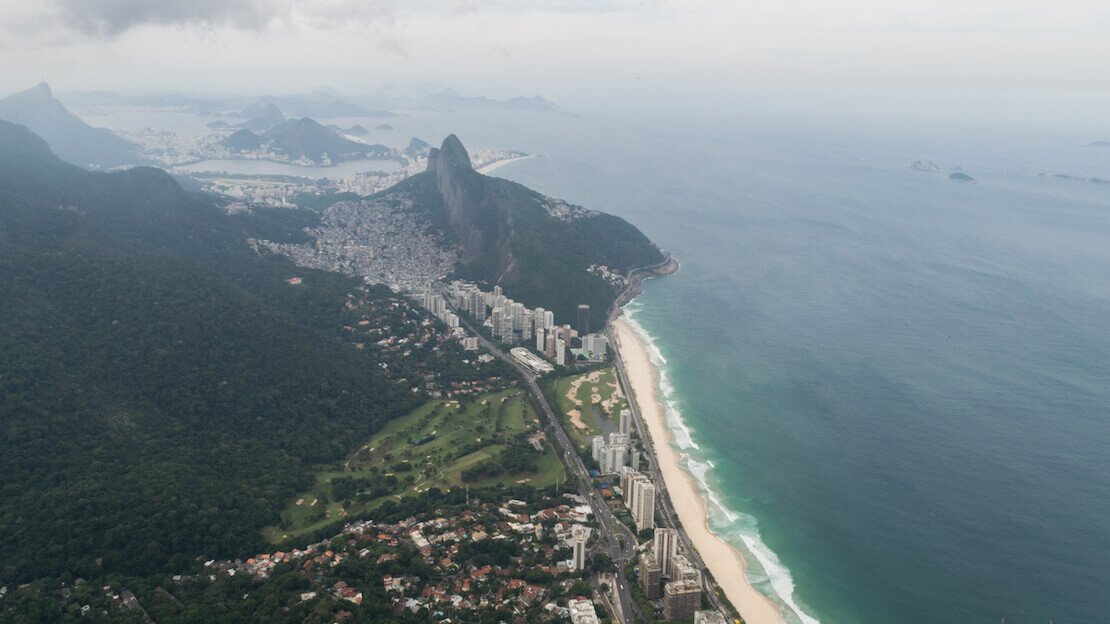
View from Piedra de Gavea.
Dois Hermanos
Another icon of Rio de Janeiro is the “Two Brothers,” two giant rock formations on the coast at the end of Ipanema. Climbing to the top of the larger one is much easier than it looks; the path is short and not too steep, and in less than an hour, you can easily reach the top, where the view is spectacular.
For many, the biggest “problem” is reaching the beginning of the trail because you must cross a pacified favela (pacified favelas are favelas with a constant police presence). The first step is to get to the entrance of the favela Vidigal (Google Maps), which is along the same bus line to go to the Pedra da Gávea or take a taxi/Uber; from here, moto-taxis take you to the beginning of the trail for about 10 BRL, and while the ride is fun, it is advisable to choose a car for those who are faint of heart.
The motorcycle/car ride to the trailhead takes only a few minutes, and in less than an hour, you will be at the top. I then walked down following the main road made a few hours earlier by motorcycle to save a couple of bucks and get a closer look at the favela. Alternatively, you can take another taxi. As already mentioned, the favela is pacified and, therefore, no more “dangerous” than other areas of Rio.
These listed so far were for me the best activities/excursions done during my stay in Rio, but there is so much more to do: I recommend spending at least a day at the beach in Copacabana or Ipanema, visiting the Museu do Amanhã (“Museum of Tomorrow,” free on Tuesdays), the spectacular Escadaria Selarón (Google Maps), the Metropolitan Cathedral de São Sebastião (Google Maps), the Botanical Garden (Google Maps), the library Real Gabinete Português de Leitura (Google Maps) and the Maracanã (Google Maps). These are just a few of the many noteworthy sites in this city that could keep you busy for weeks.
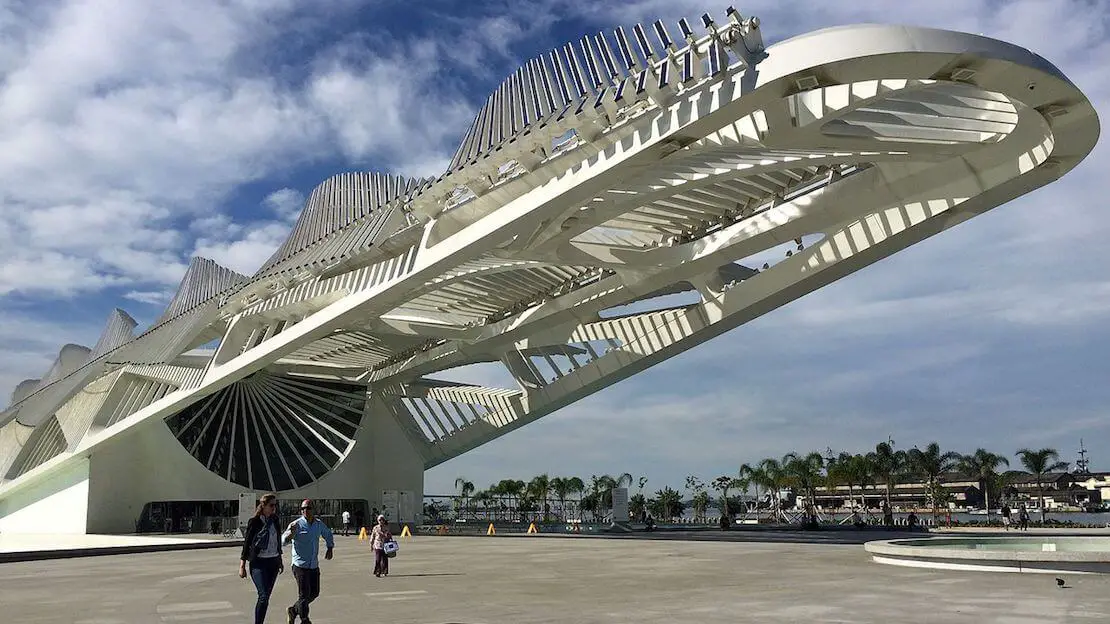
Where to sleep in Rio de Janeiro?
Most travelers stay close to downtown and nightlife in Lapa/Santa Teresa. I strongly recommend the Mambembe Hostel, one of the best hostels I have ever stayed in; it is not a party hostel but still very social, a good compromise. However, if you are looking for a classic party hostel where staying sober is not an option, check out Books Hostel.
If, on the other hand, you are looking for accommodation near the beaches, then check out the hostels around Copacabana and Ipanema; there are hundreds of options. If you are not interested in nightlife and beaches, I advise finding accommodation near a subway stop.
How to reach Rio de Janeiro?
Coming from Ilha Grande, the cheapest way is to take the 5:30 p.m. ferry to Mangaratiba, BRL 15, and then the 7:40 p.m. Costa Verde bus, BRL 33.
The more expensive alternative, but also more practical and faster, is to use easy transfer; the cost is BRL 95 for the Ilha Grande – Rio route and includes a minivan transfer directly to the accommodation in Rio plus a speed boat from Ilha Grande to Mangartiba.
From Rio, there are direct bus and plane connections to all major cities in Brazil.
Búzios
Armação dos Búzios, often called simply Búzios, is a town located on a peninsula that is only a 3-hour bus ride from Rio. It was unknown for years until the famous actress Brigitte Bardot visited it. The peninsula offers 23 different beaches of rare beauty.
What to do and see in Búzios
Búzios is primarily a beach destination and, as such, during the high season from November to March, which coincides with the best period for nightlife, it can get extremely crowded. The best time to visit is during April and May.
In addition to visiting the many beaches — those to the west are more suitable for swimming while those to the east are great for surfing, windsurfing, and kitesurfing — you can join boat tours offered by many local agencies to nearby islands, go diving, or enjoy the nightlife.
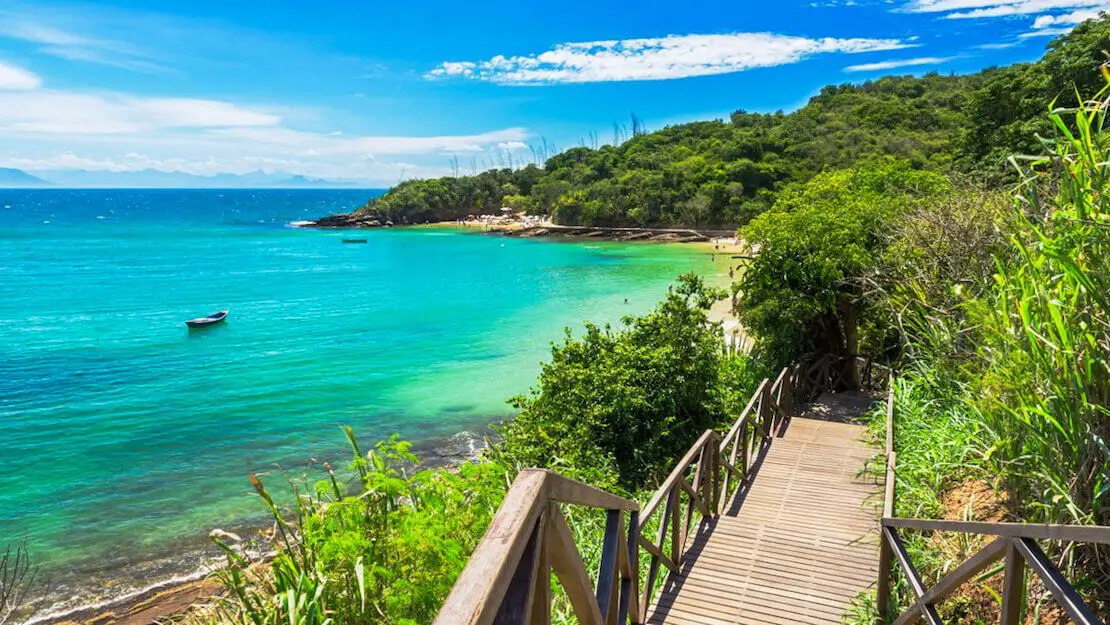
Búzios.
Where to sleep in Búzios?
5to Elemento House is an excellent facility with a pool, kitchen, and breakfast included, just a short walk from the sea.
How to reach Búzios?
By bus from Rio, it takes about 3 hours; the 1001 company serves the route.
Brasilia
Brasília is the capital city of Brazil and is also a classic “foundation city,” meaning it was created based on a specific political will and urban design. The basic structure of the city was built in only four years, from 1956 to 1960, and is shaped like a giant bird or airplane.
What to do and see in Brasilia
I will preface this by saying that I have not been to Brasilia, which is now a UNESCO site but is said to be a spectacle of architecture that attracts thousands of curious tourists yearly. Some of the most spectacular buildings include the cathedral (Google Maps), the Palace of Justice (Google Maps), the Palace of Congress (Google Maps), the Templo da Boa Vontade (Google Maps), the Santuário Dom Bosco (Google Maps), the Centro Cultural Banco do Brasil (Google Maps), and the Cláudio Santoro Theater (Google Maps). You can find a complete list here, and here is an interesting article.
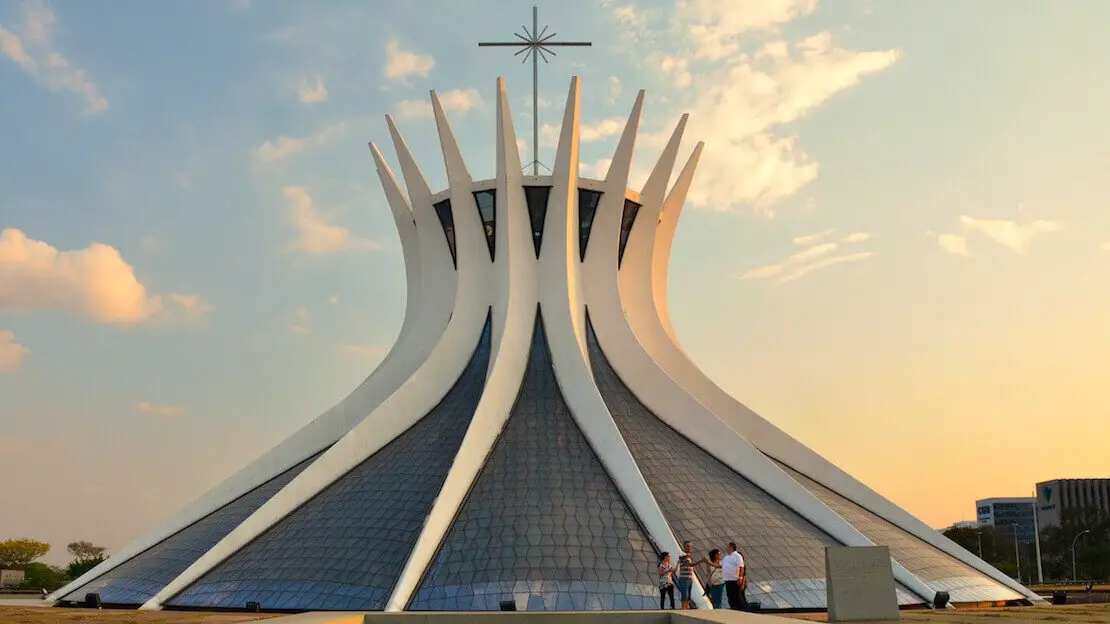
Brasilia Cathedral.
Where to sleep in Brasilia?
Joy Hostel & Suítes seems to be among the few hostels in the city; the reviews are great.
How to reach Brasilia?
Brasília is centrally located and, therefore, is well served by a bus network connecting it to the rest of the country. Possible destinations include Campo Grande (Pantanal), about 20 hours away; São Paulo, 15 hours away; Rio de Janeiro, 18 hours away; and Belo Horizonte, 10 hours away. It is also worth considering domestic flights for faster travel.
Salvador
Founded in 1549, Salvador was the crossroads of the slave trade for years, and it was the capital of the Portuguese colony. It preserves a beautiful historic center named a UNESCO World Heritage Site. In addition, Salvador’s carnival is said to be second only to Rio’s.
What to do and see in Salvador
The Cidade Alta, literally “high city,” is a fantastic collection of colonial buildings from the 17th and 18th centuries. The Pelourinho center is where Salvador’s most beautiful churches and buildings were built during the city’s golden age; Praça da Sé (Google Maps) and Terreiro de Jesus (Google Maps) are the two main squares.
I recommend ending the day by walking along Baía de Todos Santos (the city’s bay), perhaps taking the popular Elevador Lacerda (Google Maps). This public elevator connects the lower part of the city to the upper part.
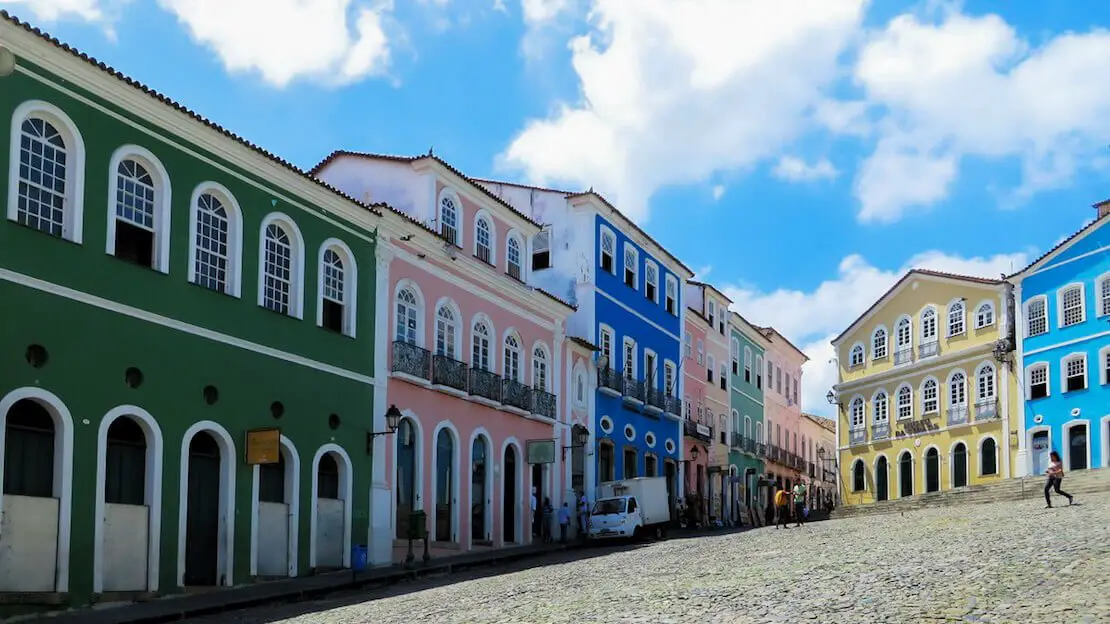
Salvador historic centre.
Itacaré
Small seaside town relatively close to Salvador, with great beaches and surfing conditions, a destination for many backpackers. I have not personally been there, but these guys whose blogs I follow speak highly of it. The article.
Where to sleep in Salvador?
Hostel Galeria 13 is a good hostel downtown. It is more expensive than competitors but nice and has extremely friendly staff.
How to reach Salvador?
You can reach all major Brazilian cities by bus, but given the distances and the low cost, I recommend looking at domestic flights.
Recife
Recife is one of the most important cities in northern Brazil. Founded by the Dutch at the mouth of a river, it is characterized by numerous bridges and canals, earning it the nickname of Brazilian Venice.
What to do and see in Recife
Recife’s historic city center, located in the Recife Antigo district, is a classic example of colonial architecture and is worth visiting. I recommend exploring the area around Praça do Marco Zero (Google Maps). Here, we find the city’s most important government buildings and the port, once the busiest in all the Americas.
On the other hand, Zona Sul is the most modern part of the city. It was built along the coast and includes the Boa Viagem neighborhood, where the beach of the same name, the city’s most beautiful, is located (Google Maps). Given the modern buildings and the beautiful beach, this area is also called the Copacabana of the northeast.
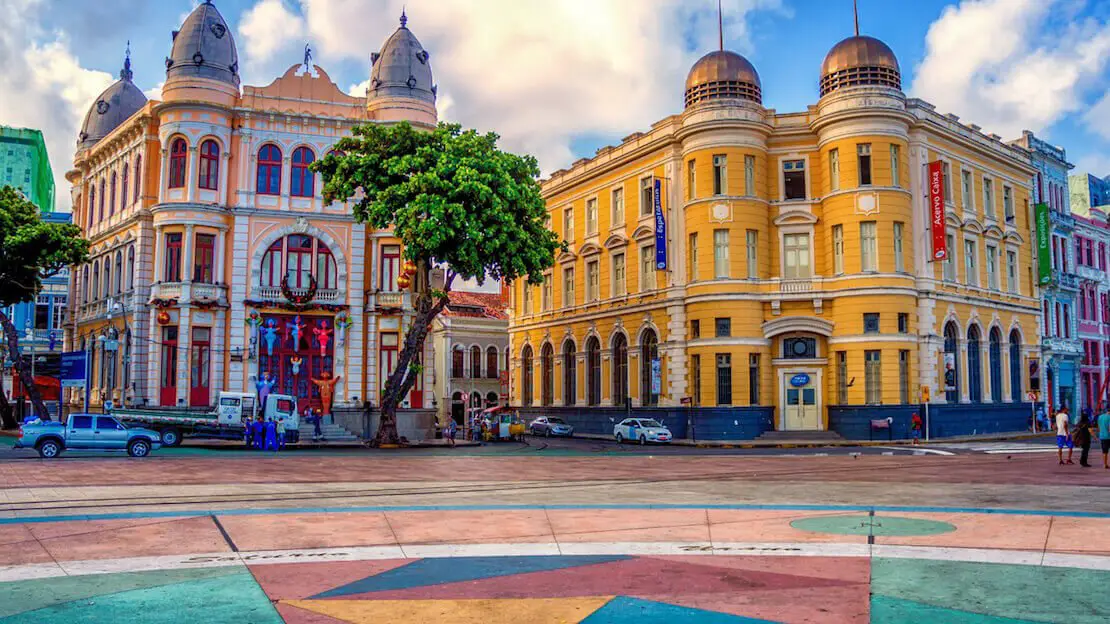
Recife historic centre.
Olinda
If you are in Recife, Olinda is worth a day trip. In addition to hosting one of Brazil’s best carnivals, it is, in fact, a UNESCO site thanks to its many buildings dating from the 16th and 17th centuries. It is only 7 km from Recife, and connections are frequent.
Porto de Galinhas
It is a small seaside town not far from Recife, with spectacular beaches and natural pools (Google Maps) formed by the proximity of the coral reef to the coast. The area is also extremely popular with locals and can get crowded on weekends.
Porto de Galinhas is about 2 hours by bus from Recife; Cruzeiro is the company covering the route.
N.b. The climate in the area is tropical with two distinct seasons; the rainy season from April to August is obviously to be avoided since the main activities are beach-related. The dry season is from September to March.
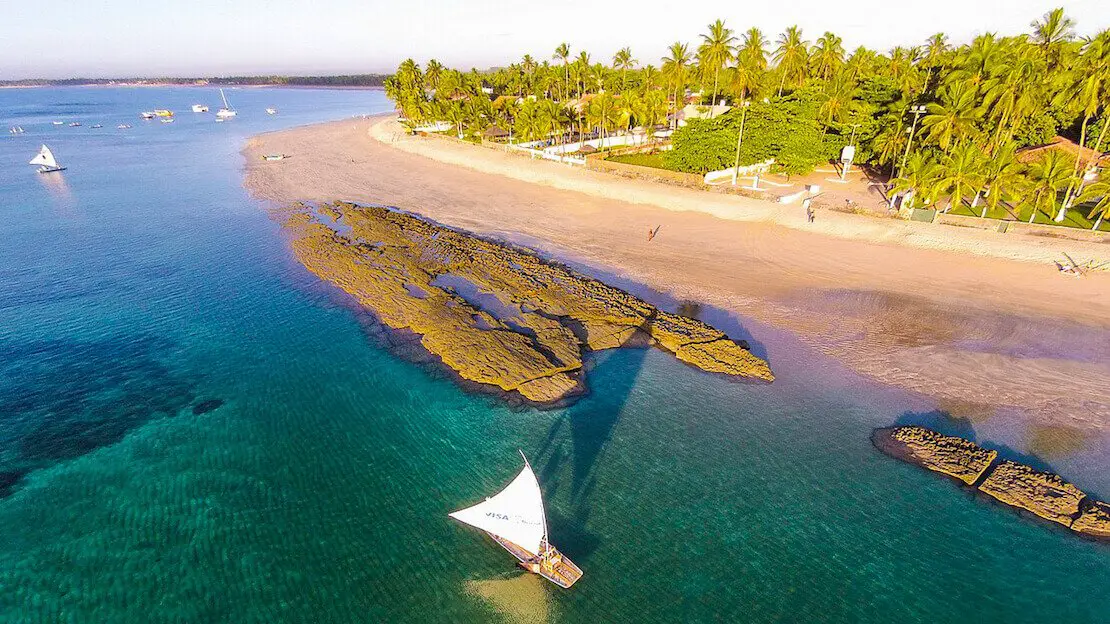
Porto de Galinhas.
Where to sleep in Recife?
Zili Pernambuco – Hostel Pousada is a good hostel in the center of Recife Antigo.
How to reach Recife?
The long-distance bus terminal is located slightly outside the center but connected by the metro. Destinations like Fortaleza (12 hours) and Salvador (about 16 hours) are possible by bus. For all others, consider domestic flights.
Fortaleza
It is Brazil’s fifth-largest city in terms of population and, unfortunately, one of the most dangerous in the country. Many use it as a hub to reach nearby Jericoacoara and the Lençóis Maranhenses National Park. While it may not be the most beautiful city in Brazil, it is still worth a visit.
What to do and see in Fortaleza
The main tourist area extends from downtown to the fish market. The waterfront on Avenida Beira Mar (Google Maps) is probably the prettiest part of the city.
Canoa Quebrada
This small town south of Fortaleza has been a “hippie” destination for years. It has recently seen a lot of development with the construction of numerous resorts but still remains a good option for those traveling on a budget, the beach with the spectacular cliff behind it is fascinating and the climate is great practically all year round (little rain between March and May) making it a beach destination to consider given also the accessibility from Fortaleza to which there are numerous bus connections every day.
Jericoacoara
A small paradise in northern Brazil, the fame of this place, which was just a small fishing village until twenty years ago, is well deserved. The fantastic beach, roads made only of sand, and an extremely relaxed atmosphere make it easy for travelers to get stuck here.
The entire area, which became a national park in 2002, now has many building and tourism-related restrictions to preserve it. Lighting in the streets is still prohibited by local law.
You can go almost anywhere by dune buggy. A popular excursion is to the freshwater lagoons around the village, costing about 30 BRL.
Here you can find a detailed guide on how to reach Jericoacoara from Fortaleza.
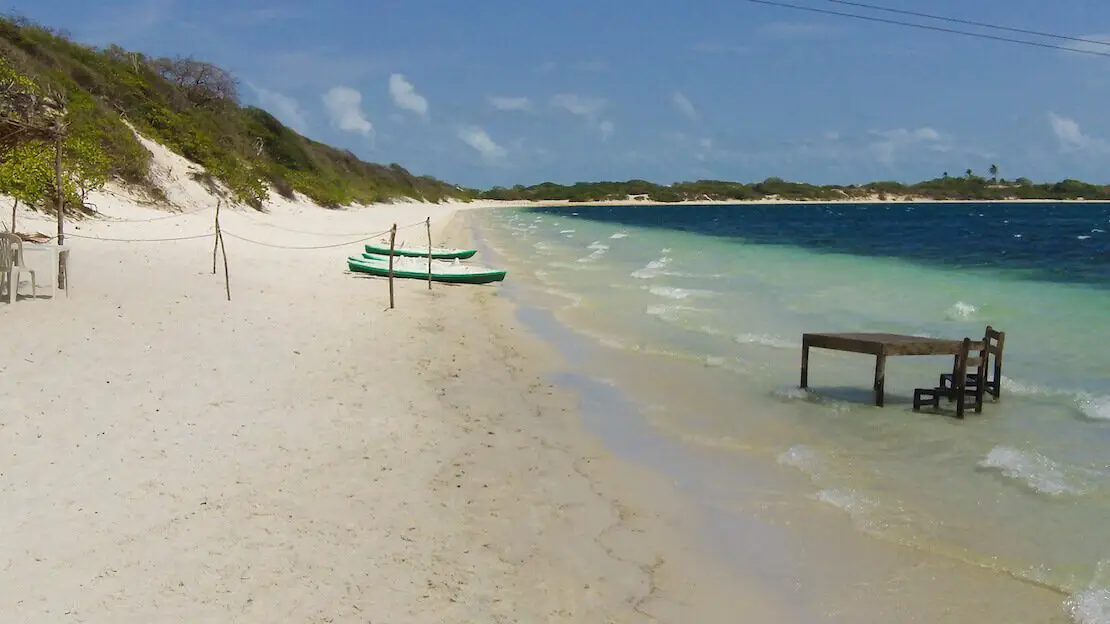
Jericoacoara.
Lençois Maranhenses National Park
Probably one of the most incredible places in the world, the park consists of white dunes that fill with rainwater during the rainy season (May – September), forming lagoons between one dune and another – a surreal landscape!
The park can only be visited by organized tours in 4x4s. The best place from which to do this is the city of Barreirinhas or São Luís further north (3-4 hours away). You can reach the area by private transport from Jericoacoara via Parnaíba (transfer offered by some local agencies). The method of making the journey by public transport is explained here.

Lençois Maranhenses National Park.
Manaus
Manaus is the main crossroads for visiting the Amazon rainforest. I haven’t personally visited the area, having already explored the Amazon rainforest in Peru, so I don’t have much information about it. Once you arrive in the city, I advise you to visit some local agencies, and evaluate them, perhaps by looking at some online reviews.
Usually, the packages offered in these situations involve staying 2-3 or more days in a lodge inside the forest, from where you can do a variety of activities, or the more expensive cruises on the Amazon.
How to reach Manaus?
There are no bus connections to other major cities in Brazil, but it is possible to travel north to Venezuela. There are frequent air connections to major cities in the country. By boat, reaching Belém (about five days), Tabatinga in Colombia (one week), Iquitos in Peru, and many other destinations along the river and its tributaries is possible.
Where to sleep in Manaus?
Local Hostel Manaus seems to be the best option in town.
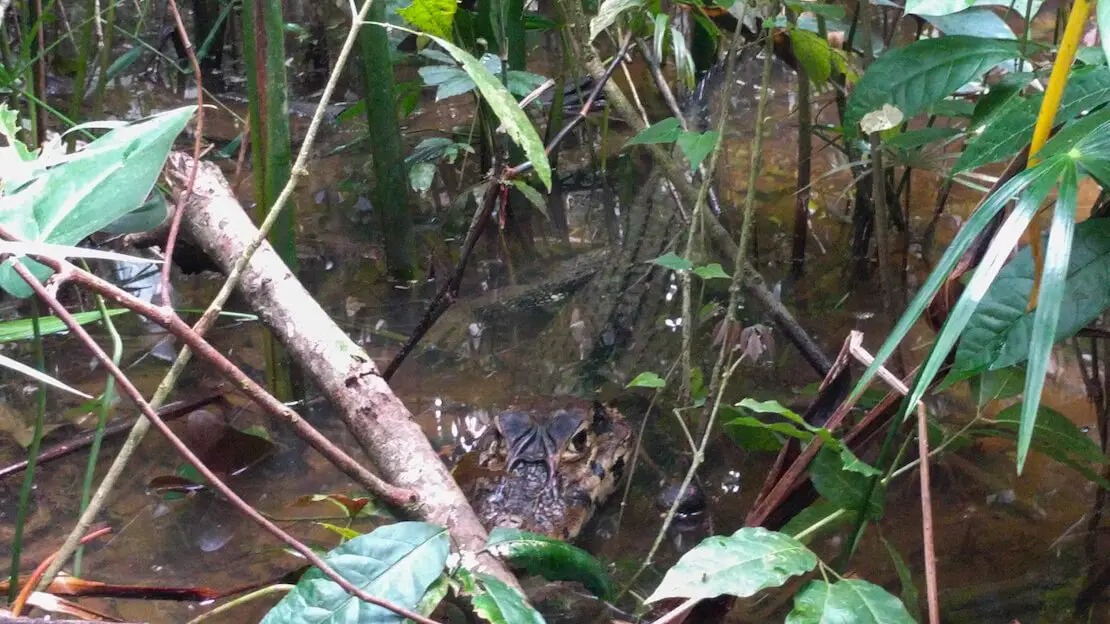
Caiman in the Amazon Forest.
Since I no longer run ads, if you found this article helpful, please consider purchasing your travel insurance through one of the links on this site. Doing so supports my work at no additional cost to you. For EU and UK residents, I recommend True Traveller. For everyone else, I recommend HeyMondo, which offers a 5% discount. Thank you for your support!
Possible itineraries in Brazil
To visit all the places I have mentioned so far probably requires at least two months, but below, I list possible itineraries of 2, 3, and 4 or more weeks. As with any country, there is no perfect itinerary given a time frame, and the vast distances and many different climates mean certain regions can only be visited at certain times of the year. So take what follows as inspiration and modify or create the itinerary according to your interests and budget!
15-day Brazil itinerary in the south of the country
This itinerary is designed for a trip to the country’s south, including cities, beaches, and nature. The months from June to September are to be avoided as it is “cold”, destinations such as Ilha Grande and especially Florianopolis, would not make much sense.
N.b. Rio de Janeiro is the ideal departure and arrival airport, but São Paulo and Porto Alegre are also fine.
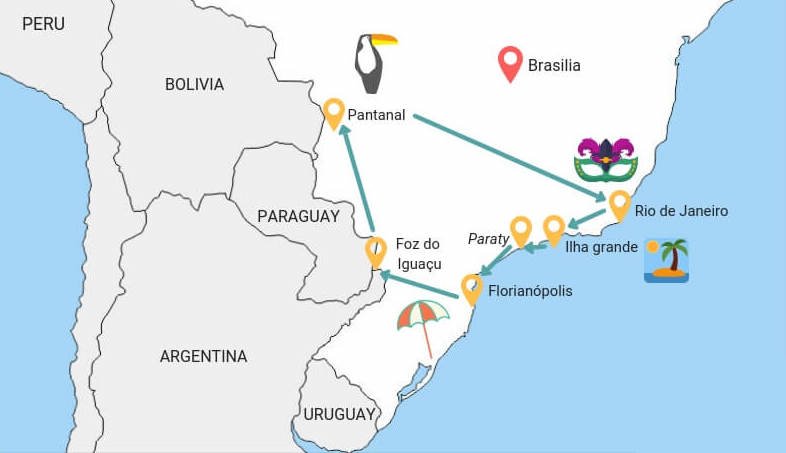
Rio de Janeiro (3 nights)
Day 1:
Recover from jet lag with a relaxing day at the beach in Copacabana or Ipanema.
Day 2:
Cristo Redentor in the morning, Lapa in the afternoon (Escadaria Selarón steps, São Sebastião Metropolitan Cathedral), Pan de Azucar for sunset.
Day 3:
Pedra de Gávea o Dois Hermanos.
Ilha Grande (3 nights)
Day 4:
Transfer to Ilha Grande in the morning. Relax at the beach in the afternoon.
Day 5:
Day at Lopez Mendez beach.
Day 6:
Pico do Papagaio in the morning, Cachoeira Da Feiticeira Waterfall, a boat tour, or a relaxing day at the beach are all viable options.
Paraty (2 nights)
Day 7:
Transfer to Paraty in the morning. Enjoy the historical center in the evening.
Day 8:
Day trip to Trindade, waterfalls, or boat tours.
Florianópolis (3 nights)
Day 9:
Long day by bus. Unfortunately, there are no direct buses, so you must go through São Paulo. Take a bus from Paraty to São Paulo in the late morning and then an overnight bus or plane from São Paulo to Florianópolis.
Day 10:
There are 42 beaches in Florianópolis.
Day 11:
See above. Evening night bus to Foz do Iguaçu or domestic flight.
Foz do Iguaçu (1 night)
Day 12:
Visit Iguazu Falls and Parque das Aves in the morning and early afternoon. Then, take a night bus to Campo Grande in the evening. Alternatively, you can take a bus to Dourados and then transfer to Bonito.
Pantanal (3 nights)
Day 13-14-15:
Time is tight to explore Pantanal, but by arranging something in advance or contacting a local agency, I’m sure you can get something done, although ideally, you should have a few extra days. On the last day, take a domestic flight to Rio or your departure airport.
20-day Brazil itinerary in the south of the country
With 20 days to spare, I recommend following the two-week itinerary just described and spending a few extra days along the various stops. Other possible destinations to include could be Búzios or crossing into neighbouring Paraguay from Foz do Iguaçu and visiting the nearby ruins of Trinidad.
15-day itinerary in Brazil in the north of the country
This itinerary is designed for travelling exclusively in the north of the country. It is possible to follow this itinerary year-round, although March through June/July tends to be particularly rainy in some areas. As always, my two-week itineraries have very tight time frames, and having a few extra days available would be ideal.
N.b. Salvador is probably the cheapest departure and arrival airport, but Recife, Fortaleza, and Belém are also fine.
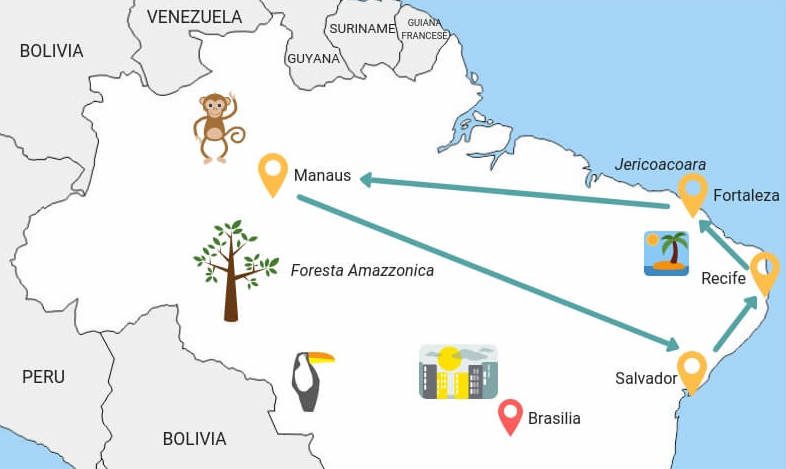
Salvador (2 nights)
Day 1:
Recover from the jet lag and explore the historic center.
Day 2:
Enjoy the city in the morning and take the bus to Recife in the afternoon.
Recife (5 nights)
Day 3:
Explore the historical center in the morning and the Sul area in the evening.
Day 4:
Visit Olinda during the day.
Day 5-6-7:
Beach and sea in Porto de Galinhas. On the last day, return to Recife and take an overnight bus to Fortaleza.
Fortaleza (4 nights)
Day 8:
Day in Fortaleza.
Day 9:
Transfer to Jericoacoara.
Day 10 – 11:
Beach and sea in Jericoacoara.
N.b. You could eliminate a few days or stops here and there to visit the nearby Lençóis Maranhenses National Park. With public transportation, it takes two days from Jericoacoara, while private transportation in a jeep takes 7 to 8 hours. Some agencies in Jericoacoara also offer complete transportation packages plus park tours, but these are not exactly low-cost options. Ideally, you should have a few extra days.
Manaus (3 nights)
If you visit the Lençois Maranhenses National Park, consider flying from São Luis; otherwise, return to Fortaleza and fly to Manus.
Day 12-13-14:
3-day tour of the Amazon rainforest.
Day 15:
Return home.
20-day itinerary in Brazil in the north of the country
As you may have already guessed, 20 days, in my opinion, is ideal to follow the itinerary just described, visiting the Lençóis Maranhenses Park and spending a few more days wherever you feel the need.
Itinerary of 4 weeks or more in Brazil
With four or more weeks available, you could combine the two itineraries just described; however, pay attention to the time of year, as some months in the north of the country are very rainy, and others in the south can be “cold.”
Probably the ideal time window for such a trip is from August to October.
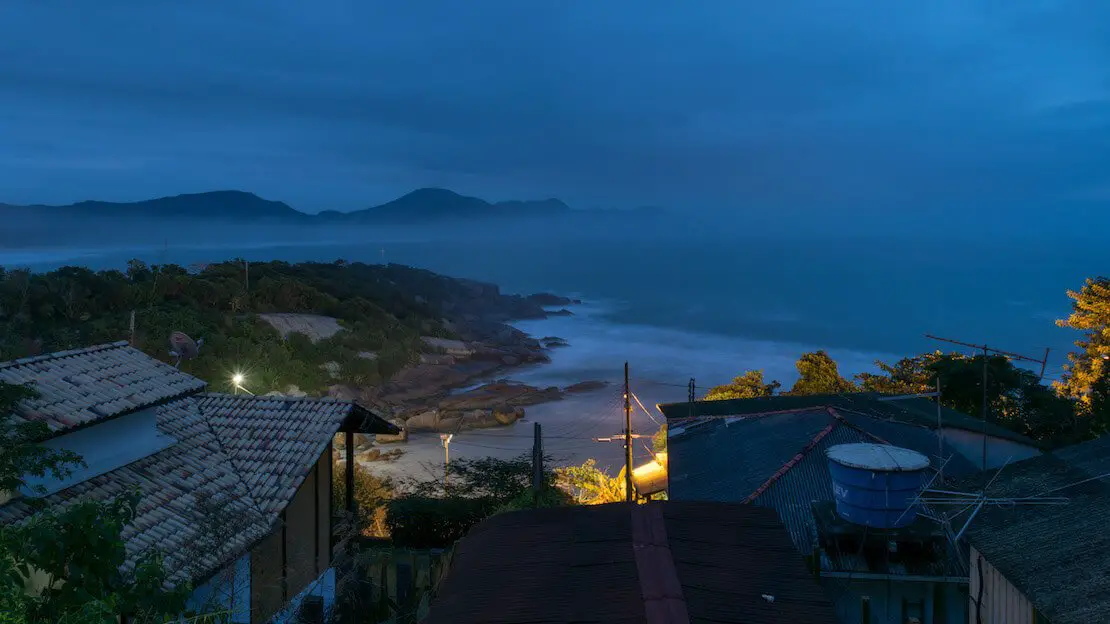
Florianópolis.
How to get around Brazil
Buses in Brazil
Buses are by far the most common and cheapest way to get around. They are usually of a very good standard, clean, and modern, and some even provide pillows, blankets, and food on board. Each city’s bus terminal (rodoviária) has connections to all other major cities in the region. All trips longer than 4 hours are covered by buses with on-board bathrooms.
There are different types of buses for long distances: “Leito” buses are the most comfortable and have only three rows of seats instead of 4, so they are extremely spacious and seats recline up to 160 degrees. Often, double-decker buses have the second floor with leito seats while the lower deck has semi-leito seats, which recline less and are narrower (classic rows of 4).
No one company covers the whole country, so to get an idea of schedules and routes, I recommend looking at sites like brazilbustravel or Busbud. But remember that not all companies have an online presence. I often bought my tickets directly at the bus terminal.
Domestic planes in Brazil
The two main local companies are LATAM and Gol, which handle about 80 percent of domestic traffic alone. Other companies are Azul and Avianca
If you book a bit in advance, I strongly recommend looking at internal flights; you will find very good prices. If you plan to take several internal flights, I suggest you do your math and consider doing an air pass; at the link, you will find all the relevant information.
Taxi in Brazil
The meter is used everywhere except for routes with a fixed price, as is often the case, especially from airports to the city center. For example, a ride from Rio’s Galeão Airport to Copacabana costs BRL 63.
Tourists, as always, fall prey to many tricks by taxi drivers, such as extending the route for no reason. It is always good to know how much a particular route should cost, perhaps by asking at your hostel/hotel.
In large cities, Uber works and is probably the cheapest and safest choice.
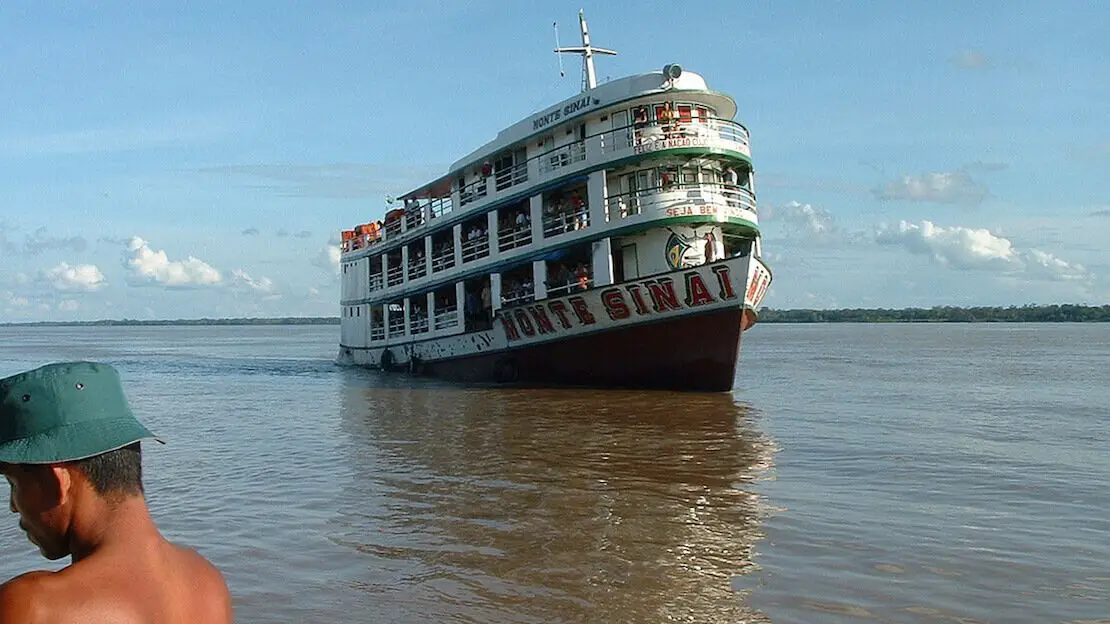
Boat on the Amazon River.
Hitchhiking in Brazil
Hitchhiking in Brazil should be done with extreme care, especially in large cities. Using a sign is strongly recommended; it would also be best to do it at a gas station.
Backpacking Brazil: costs
How much does a trip to Brazil cost?
Cost of accommodation in Brazil
A dormitory bed normally costs BRL 30-60, with breakfast often included. A double room in a hostel is also about 100-150 BRL. Small family-run hotels, also known as “pousadas,” cost, on average, 90-130 BRL.
Cost of Transportation in Brazil
Long-distance buses are convenient and cheap by European standards but not as much as in countries like Bolivia and Peru. They remain the most affordable option for medium to long distances, especially if you take night buses, so you can save the night in the hostel/hotel.
It is still worth looking at domestic flights as they are sometimes cheap compared to many South American countries. For other countries, my advice is almost always to buy your ticket at the terminal by bargaining; from personal experience, this is not the case in Brazil; here, a bit like how it works in Europe, buying online offers the same rates, and the price at the bus terminal is rarely negotiable.
Cost of food in Brazil
Food in local restaurants is inexpensive; the daily menu with drinks can be found for about BRL 20, even in expensive cities like Rio. Higher-end restaurants expect you to pay at least 50-60 BRL.
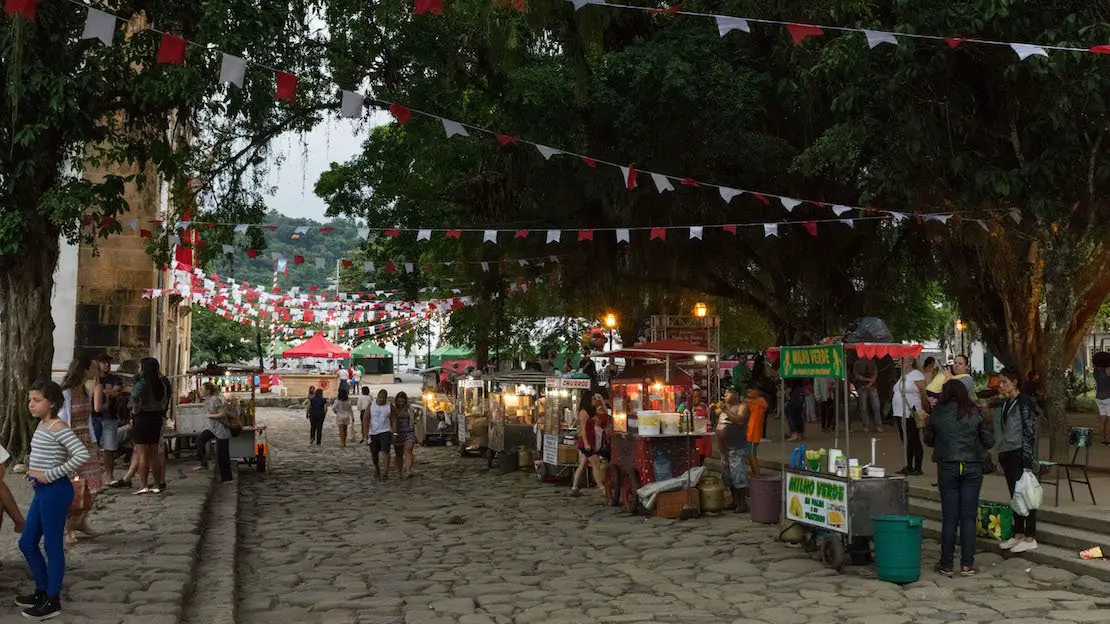
Street food in Brazil.
Backpacking Brazil: Safety
Is Brazil safe? In principle, yes, but you must be very careful in the big cities. With a little forethought and common sense, you should have no problem, but I have met people who got robbed in broad daylight while walking up the road to Cristo Redentor in Rio (a touristy place, to say the least), and many others who had their phones and cash taken away while walking the streets of Lapa late at night. If something like this happens, do not resist for any reason.
Honestly, during my almost ten days in Rio, although I walked back to the hostel late at night, sometimes even alone, I never had any problems; it is also true, however, that I never went out with anything more than a bit of cash for which I would never have resisted. If, however, you feel unsafe, I recommend getting around as much as possible by taxi.
That said, do not be afraid; Brazilians, for the vast majority, are hospitable and kind people; use common sense and you will not have any kind of problem.
Are you planning a trip to Brazil? Check out these posts:
Do you have any questions? Updated information? Feel free to leave a comment or message me on Instagram!
Since I no longer run ads, if you found this article helpful, please consider purchasing your travel insurance through one of the links on this site. Doing so supports my work at no additional cost to you. For EU and UK residents, I recommend True Traveller. For everyone else, I recommend HeyMondo, which offers a 5% discount. Thank you for your support!
For donations/pizzas and virtual beers 🙂
Did you like the post? Pin it!
